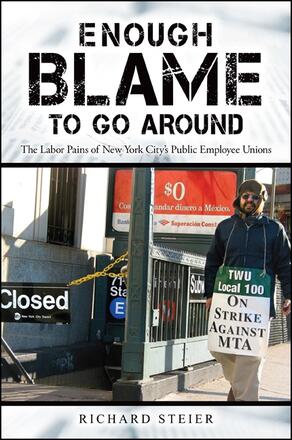
Enough Blame to Go Around
The Labor Pains of New York City's Public Employee Unions
Alternative formats available from:
Veteran labor journalist Richard Steier explores the tensions between New York City's public employee unions, their critics, and city and state politicians.
Description
Since 1980 Richard Steier has had a unique vantage point to observe the gains, losses, and struggles of municipal labor unions in New York City. He has covered those unions and city government as a reporter and labor columnist for the New York Post and, since 1998, as editor and featured columnist of the Chief-Leader, a century-old independent newspaper that covers city and state government in greater detail than today's mainstream news organizations. Drawing from his column with the Chief-Leader, "Razzle Dazzle," Enough Blame to Go Around describes in vivid terms how the changed economy has drastically altered the city's labor landscape, and why it has been difficult for municipal unions to adapt. There can be no doubt, he writes, that public employee unions have contributed to the problems that confront them today, including corruption and failed leadership. But at the same time and for all their flaws, he believes unions represent the best chance for ordinary people to receive fair economic treatment.
Veteran labor journalist Richard Steier is editor and columnist for the Chief-Leader and the coauthor (with Len Ragozin and Len Friedman) of The Odds Must Be Crazy: Beating the Races with the Man Who Revolutionized Handicapping and Created The Sheets. He lives in Bellerose, New York.
Reviews
"The book provides a crash course into New York public sector labor relations. Readers will learn a surprising amount about pension legislation—for those of us in the public sector, Steier's explanation of the Variable Supplement Fund alone is worth the book's price—and the 30-plus years' erosion of union power in the city. " — Solidarity
"The New York City public sector is the largest municipal workforce and as such, can provide both positive and negative lessons for union leaders. Steier's volume provides many of the lessons on both sides of the ledger and should be required reading for all union leaders, particularly those dealing with public sector employees. " — Labor Studies Journal
"Richard Steier … is the best full-time reporter on the New York City labor beat … Steier's work takes guts, not just in the timely writing but in the republishing of what could be dismissed as old news; at least old to city-based labor activists and those reading Steier religiously … How many scribblers can stand by their work a week after publication, let alone years or decades? Steier can. His is still instructive. " — Michael Hirsch, Working USA
"With 151 municipal contracts to be negotiated, this is the perfect time to peruse Enough Blame to Go Around. " — New York Times
"No one knows New York City's working men and women better than journalist Richard Steier. Whether he's depicting the heroic exploits of legendary union leaders or exposing the excesses of corrupt labor bosses or recounting pivotal battles over labor contracts, Steier always provides fresh, behind-the-scenes insight into the vast world of municipal workers, a group that too often is unfairly maligned. And he does it all with a powerful bare-knuckle style that will leave you wishing for more. " — Juan Gonzalez, staff columnist, New York Daily News
"If you want to know about municipal unions in New York City, you need to read Richard Steier. I sometimes disagree with him, but for more than two decades he has been one of the most informative and provocative chroniclers of the ins and outs of public sector labor. " — Joshua B. Freeman, author of American Empire: The Rise of a Global Power, the Democratic Revolution at Home, 1945–2000
"New York City's labor unions have been luckier than they deserved to have had reporter and editor Richard Steier around to spotlight their occasional triumphs and their much more frequent failures. Like Murray Kempton, another great New York columnist who loved the men and women of labor but who never suffered the fools who sometimes ran their unions, Steier's columns are filled with news, insight, and always compassion for those who ride (and drive) the early trains and buses to work. " — Tom Robbins, CUNY Graduate School of Journalism
"Steier presents an impassioned case for public sector unions and the benefits they have won, along with fascinating tales of the machinations inside several of the largest unions in New York City—District Council 37, Transport Workers Union Local 100 and the 2005 strike that paralyzed the city, and the United Federation of Teachers. " — Alair Townsend, former New York City Budget Director and Deputy Mayor